If you live in a temperate zone, chances are that you have encountered powdery mildew in your garden.
Powdery mildew is a worldwide menace, with hundreds of species of fungi that may cause it, and the ability to infect more than 10,000 species of plants.
According to Master Gardener Jim Cooper of the Washington State University Extension, it has been estimated that, when you factor in the total loss of crop yields and plant growth, powdery mildew produces the greatest losses of any single plant disease throughout farmers’ fields as well as home gardens.

We link to vendors to help you find relevant products. If you buy from one of our links, we may earn a commission.
Infected leaves appear as white or gray spots in the early stages of an infection. They may quickly enlarge to completely cover the infected plant parts with a nasty blight.
While these fungi do not usually kill their hosts, they do debilitate them.
However, there is hope!
In addition to weather patterns and symptoms to watch for, if you are looking for a home remedy or organic treatment, read on.
There are many options that I will cover in this guide, as follows:
What You’ll Learn
The Basics of Powdery Mildew
The fungi that cause powdery mildew are unusual in that they need their hosts to be alive, because of the intimate relationship they have with the plants.
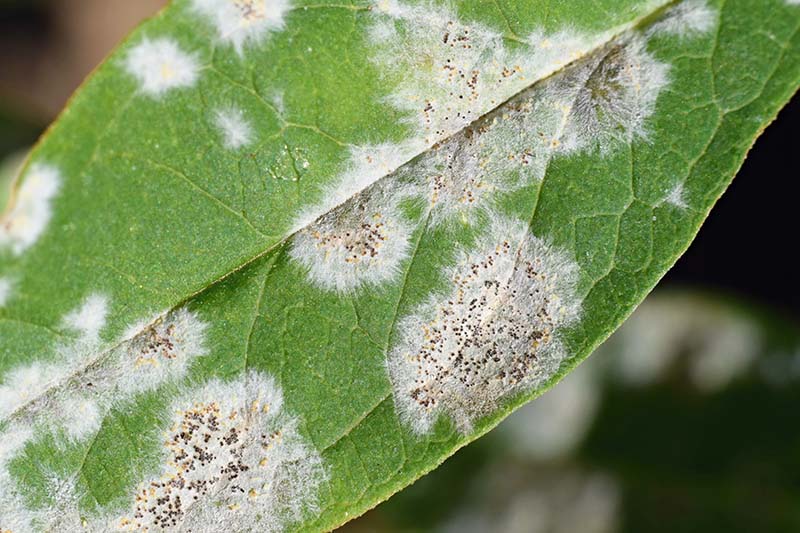
That is thought to be the reason why they don’t kill their host. They need the plant’s nutrients to survive.
And unlike most types of fungi, they cause more severe cases of disease in warm, dry weather.
A mild case may go away on its own. But without intervention on the part of the gardener and a little extra TLC, a severe infection can mean the end of your precious plants.
What Is Powdery Mildew?
Powdery mildew is the name given to the disease caused by hundreds of species of fungi in the order Erysiphales.
This name comes from the white to grayish talcum-like powder that you will notice on the leaves of infected plants. This powder is a combination of spores and mycelia (fungal threads).
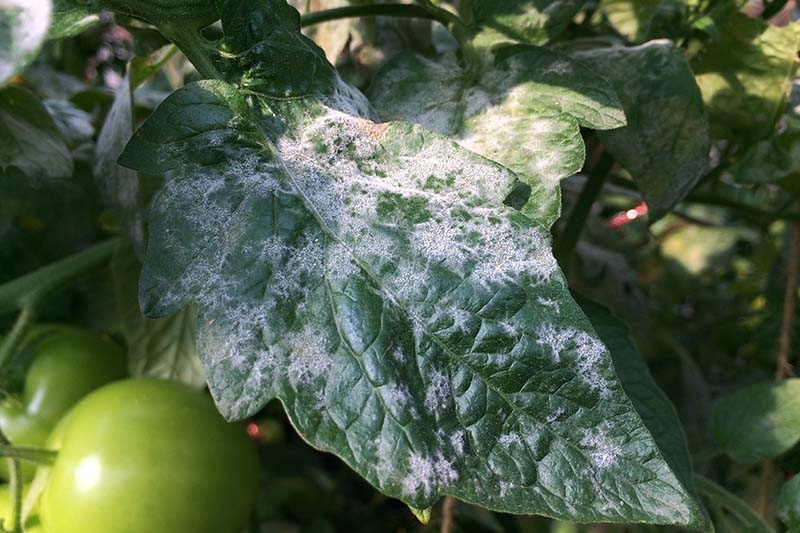
The taxonomy of fungi in this order were revised extensively based on new DNA sequence data in the early 2000s, so you may sometimes see a current as well as an old name for the type of fungi known to cause this disease in a given plant.
Like many fungi, these pathogens reproduce both sexually and asexually. These stages look quite different from each other – to the extent that there are different scientific names for each of the stages.
Spores from the asexual stage spread the disease, while the sexual stage produces fruiting bodies that are important for overwintering. These fruiting bodies used to be called cleistothecia but are now designated as chasmothecia.
Some common types include Podosphaera that infects roses and Golovinomyces that attacks cucurbits. Powdery mildew is common wherever cucurbits are grown, so vertical gardening is often recommended to improve airflow.
How These Fungi Attack Their Host
While the fungal threads of almost all species grow on the surface of leaves, these fungi send out specialized structures that live within the plant cells to siphon their nutrients. These root-like structures are called haustoria.
Because of this specialized relationship, most powdery mildews are specific for their hosts. These fungi won’t attack any plant in the area like many other pathogens that assault a wide variety of species (Anthracnose and white mold come to mind).
In other words, just because the field of barley next door is exhibiting signs of powdery mildew doesn’t mean your roses will succumb to it as well. Cucumbers and zucchini, on the other hand, may both be infected by the same species of fungi.
Conditions for Infection
Unlike most fungal pathogens, all species that cause powdery mildew can infect their host in the absence of free water.
In fact, free water can kill the spores of most types of fungi that cause powdery mildew, and inhibit the growth of the mycelia.
However, water in the air (humidity) is necessary for the spores to germinate. These fungi cause the most severe infections when the humidity is high at night and low during the day.
Spore formation is favored by high humidity, while the dispersal of spores is accelerated when the humidity is low.
Moderate temperatures in the 70 to 80°F range favor infection. Therefore, powdery mildew is often a problem in the spring and fall, when there are large differences in temperatures between day and night in many regions.
While the spores are often spread by the wind, insects such as woolly aphids can spread the infection as they feed on plants.
Infection is common in crowded plantings that have poor air circulation, and in areas that are shaded and damp.
Whereas healthy plants are often able to ward off an infection or recover on their own, stressed plants that are growing in unsuitable locations or cared for inadequately or improperly may fall prey to this fungal disease more easily.
Symptoms
Most of the infections first show white or grayish spots on the upper sides of leaves and on tender new growth. Some gardeners say this looks like a dusting of flour.
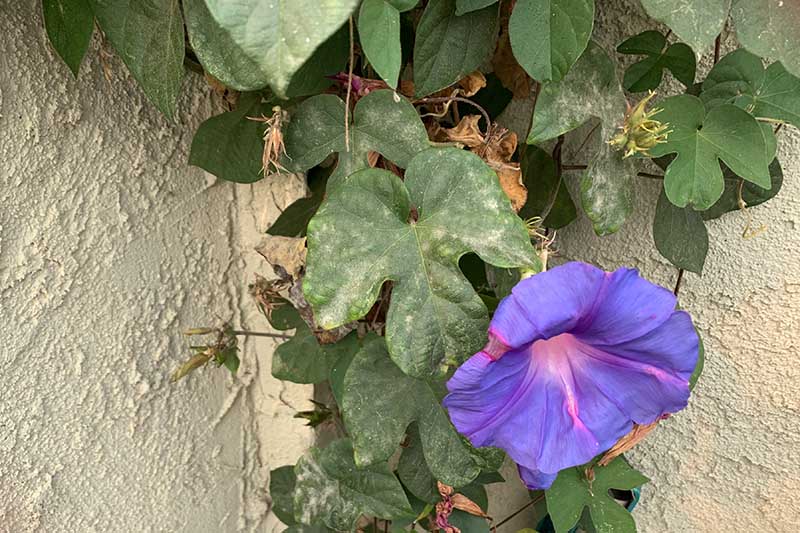
The lower leaves are most commonly affected. However, as the spots increase in size, the mildew can spread throughout the whole plant.
Flowers, young fruit, buds, and young stems can all be infected, and fungi can overwinter inside buds in warmer climates.
As the infection advances, the fungi produce fruiting structures that are the size of a pinhead. They start out white before turning yellow-brown and then black.
Leaves can become twisted and distorted before wilting and dying.

The loss of leaves can result in sunscald to fruits on the plants. This is a particular problem with cucurbits, and infected plants tend to produce fruit that are prone to sunscald, have a poor flavor, and don’t store well.
Some kinds of succulents show different symptoms when infected with powdery mildew. Infections on sedum can manifest as brown scabby spots, for example, while kalanchoe can develop corky brown spots.
Powdery mildew on tomato plants often begins with pale yellow leaf spots that develop into the typical white, powdery growth.
Types of Plants Affected
With the exception of gymnosperms, such as conifers, most of your plants are at risk of a powdery mildew infection if the conditions are right.

A small list of susceptible plants reads like a who’s who of the plant world.
Ornamental plants that can face this onslaught include:
- Asters
- Bee balm
- Begonias
- Dahlias
- Delphiniums
- Hibiscus
- Lilacs
- Mums
- Peonies
- Roses
- Succulents
- Verbena
- Zinnias
While fruits and vegetables include:
- Apples
- Beans
- Beets
- Carrots
- Cantaloupe
- Cucumbers
- Eggplant
- Grapes
- Onions
- Parsnips
- Pears
- Peas
- Peppers
- Pumpkins
- Squash
- Strawberries
- Tomatoes
- Watermelons
Even your herbs are not safe – cilantro and rosemary can be infected – as can your fruit trees, including apples and avocados.
This disease can also occur indoors, on houseplants such as African violets and poinsettias.
It’s also worth noting that some plants are known to be highly susceptible to powdery mildew under the right conditions, while others – such as annual phlox and Belladonna delphiniums – bear natural resistance.
Keep an eye out for resistant cultivars to plant in the garden, and avoid others noted for succumbing to this disease more easily, such as Sedum ‘Matrona.’
How to Control Powdery Mildew Without Conventional Fungicides
The good news is that powdery mildew infections are typically mild. Otherwise healthy plants will often recover on their own after changes in the weather, and with proper care to improve airflow.
Treatment is often unnecessary.
For severe infections or a widespread problem throughout the garden, treatment options that avoid the use of conventional fungicides are available.
The frequent use of fungicides can lead to the development of resistance in fungi. This has implications for both agriculture and human health.
Cultural Controls
Many of you have probably had a rosemary plant that succumbed to this ailment. Why might that be?
It’s often a clear case of killing your plants with a little too much love, and attacking the problem with the wrong solution, typically through over or underwatering.

Though the fungi itself needs a live host to live, and though its goal may not be to murder your beloved rosemary, the catch-22 here is that stressed plants are more prone to infection.
Without proper care, you are doing your plants a disservice and paving the way for disease, as well as other problems like pest infestations, or a failure to produce stunning flowers or high crop yields.
This is where cultural controls come into play.
A key element of organic gardening and integrated pest management (IPM), cultural controls are those elements of agriculture and gardening that deal with modifications to the growing environment.
These may include making changes to amend the nutritional content or pH of the soil, watering more or less, and making sure plants receive the right amount of sunlight.
Giving plants the conditions they need to thrive is key to keeping them healthy, happy, and hopefully disease-free.
Adequate spacing is another important factor to consider, and if you’ve been ignoring those USDA Hardiness Zones and recommended planting times for your region up until now, take heed: though you may be able to nurse a tropical plant along through the fall in a cold climate, or you’re “only” two zones away from what was indicated on the plant tag, those recommendations are there for a reason.
Since damp, crowded foliage is more susceptible to infection, prune foliage as needed to encourage proper airflow.
Sun is the enemy of fungal disease, generally speaking, so be sure to give plants whatever level of sun exposure they need to thrive, whether that’s shade, partial sun, or full sun.
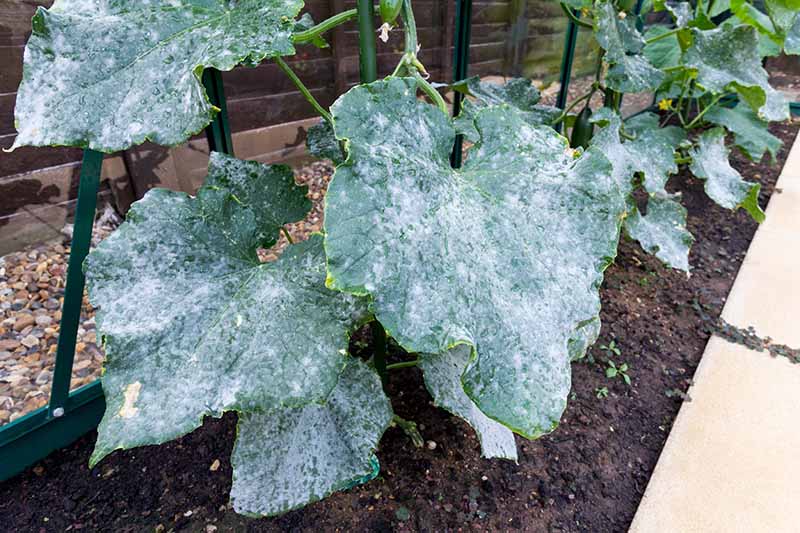
Watering overhead is sometimes recommended as a way to prevent this disease, but others strongly recommend against the practice, since it will increase the humidity in the interior of the plant. Such an increase in humidity could encourage infection, or increase the severity of an existing infection.
Take our advice: always be sure to water plants at the soil level, and avoid getting the foliage wet. Watering early in the day is typically best (as opposed to watering at nighttime) since plants will have time to dry off before nightfall.
Lush, newly formed tissue is more susceptible to powdery mildew. Therefore, if you have a problem with this disease in your garden, avoid fertilizing with nitrogen in the late summer, and always be careful to avoid overfertilizing your plants with this nutrient.
If your plants are infected, prune off the diseased tissue and destroy it. Do not put it in your compost pile, or the infection could spread into other parts of your garden.
Dormant spores can remain on plant matter and nearby weeds may also serve as hosts. Be sure to keep your garden beds and borders clean and free of weeds.
According to Dr. Gary Moorman at the Penn State Extension, some growers who raise their crops in greenhouses will syringe the leaves of susceptible plants with water during the day when humidity is low. This has been shown to work well for inhibiting powdery mildew infections, since the spores won’t germinate in the presence of water.
But this practice can greatly increase the plants’ chances of contracting other types of disease, such as fungal leaf infections. We don’t recommend it.
Milk
Spraying milk on areas of plants that display symptoms will help to control powdery mildew, particularly if it is applied at the early stages of an infection.
This technique is used by many organic growers around the world, and has been found to be effective in studies conducted over the course of over 60 years on tomatoes, grape vines, apples, pumpkins and other types of winter squash, cucumbers, zucchini, and other types of plants.
Results of one the above-referenced study on pumpkins and acorn squash indicated that this readily available product could provide control similar to that achieved via the use of conventional chemical fungicides, whereas applications of compost tea were not found to be effective. Treatment with milk was most effective at the early stages of infection.
The common advice is to dilute milk at a ratio of 1:10 with water and spray it on your plants at the first sign of infection.
Powdered or liquid milk may be used. However, according to the available research to date, higher concentrations of milk may prove to be the most effective.
Try a 50/50 mix of liquid milk to water for moderate to severe infections, or even full-strength milk if you don’t have a large area to cover.
Some experts say raw or organic milk is best, and the fats in whole or 2 percent milk can serve as an impediment to treatment, whereas others claim it makes no difference what type you use.
Add the liquid to a spray bottle, and be sure to cover all of the affected areas of your plants, including stems and the undersides of leaves. Continue applications twice a week until you see results, and be sure to reapply if you’ve had rain.
You shouldn’t need to worry about milk spots on plants’ leaves (less unsightly than the mildew at least, if you do see any), though the spray can develop a sour smell in the hot sun. Better than having sick plants on your hands, of course!
Milk can also help to prevent infections if you spray it weekly on your plants.
Sodium and Potassium Bicarbonate
Researchers have been testing the effectiveness of baking soda (sodium bicarbonate) as a fungicide since the early 1930s and found that it is ineffective as a fungicide on plants, although it can inhibit the growth of molds in the lab.
According to Dr. Linda Chalker-Scott, Associate Professor of Plant Pathology and Extension Specialist at Washington State University, it may be useful for keeping harvested fruits and vegetables from rotting.
But we can’t recommend it as a treatment for powdery mildew.
However, there are some fungicides that combine the closely related compound, potassium bicarbonate, with additional components. One such product is Kaligreen. Another is MilStop, which is available from Arbico Organics.
Both of these formulations are listed by the Organic Materials Review Institute (OMRI) as approved for organic growers, and safe for home use. Read product labels for application instructions.
Sulfur
Sulfur is a classic fungicide that is effective for controlling powdery mildew, but the catch is that it must be applied preventively, in advance of symptoms. You can spray it on plants that you know to be susceptible, to prevent infection.
It is considered to be one of the most effective and least expensive products to use against the fungi that cause this disease.
Many sulfur product labels will indicate that it can be applied immediately at the onset of infection, but results may vary.
Some powdered products include surfactants, to make them easier to mix with water and spray onto plants.
Bonide Sulfur Plant Fungicide is available from Arbico Organics. This formulation can be applied as a dust or mixed with water and applied with a pressure sprayer.
Sprays should typically be applied weekly and after rain, but this will depend in part on what type of plant you are treating.
Do not apply sulfur to any plants that have been treated with horticultural oils for at least two weeks, and avoid application if temperatures are expected to exceed 80°F.
Some gardeners also opt to brush or dust sulfur products onto the leaves of their plants, but it is important to note that these products may be irritating to the eyes and throat, and are not suitable for use on all types of plants.
Be sure to wear proper protection, and read all product labels carefully before use. Use should be avoided on certain types of apples, grapes, squash, and melons.
Biofungicides
There are a number of different types of microbes that are marketed to control this disease and that are approved by OMRI as organic.
One advantage of using biofungicides is that they don’t leave toxic residues behind, and the fungi are much less likely to become resistant to them.
The active ingredient in Actinovate AG is a highly studied strain of Streptomyces lydicus, while Double Nickel 55 LC and WDG contain the commonly used biocontrol bacterium Bacillus amyloliquefaciens, as do Serifel and Taegro 2.
Aviv and Companion contain different strains of Bacillus subtilis.
Arbico Organics sells a formulation of these bacteria called Cease that is effective against this type of fungal disease.
All of these microbes are sprayed on the leaves, typically once a week, but as often as every three days if you opt to use Cease to treat active infections. Again, always read product labels and follow the recommended application instructions.
Copper
Copper is a common fungicide that may be effective against powdery mildew, and it may also be used to control some types of bacteria. Many preparations are certified organic.
However, some experts claim that it is limited in its effectiveness, particularly in comparison to sulfur.
Arbico Organics sells Bonide Liquid Copper Fungicide, a low-concentration copper octanoate spray. This is a form of copper that is bound to a soap.
The ready-to-use formulation hooks up to your hose, and then you spray it on your plants. It is most effective if you apply it preventively, similar to sulfur.
If your plant is infected, apply copper as soon as you notice symptoms, and repeat every seven to 10 days. Make sure to spray both the tops and undersides of leaves, and reapply if it rains.
Rated as “slightly toxic” by the EPA, be sure to follow product instructions closely, cover exposed skin, and avoid contact with your eyes or inhalation when applying this product.
Copper is toxic to fish, so do not use near ponds or streams.
There Is Hope in the Fight Against Powdery Mildew
Fear not if you see powdery growths on your plants. Such infections are treatable, and you don’t even have to resort to using conventional fungicides.
A range of options are available, and many of them are certified organic.
However, as with most treatments, they are the most effective if you catch an infection at the early stages.
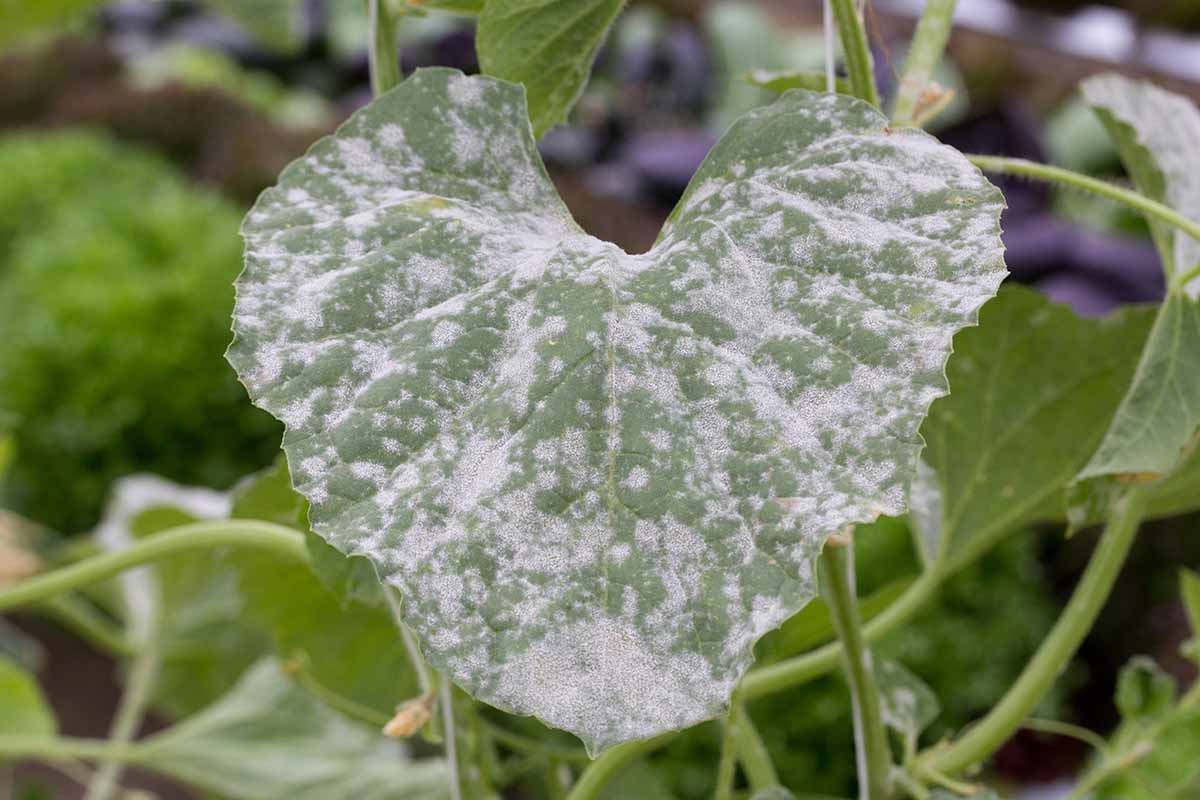
If you’ve had repeat problems with powdery mildew in your garden, consider planting resistant varieties of your favorite flowers, fruits, and vegetables next year. Cultivar descriptions in catalogs and on seed packets will include this information.
Many types of produce have been bred to have resistance to this disease, particularly certain varieties of cucumbers and other cucurbits like pumpkins, cantaloupe, and various types of summer squash, as well as brussels sprouts, bush beans, and strawberries, just to name a few.
Resistant annual and perennial flower cultivars include certain types of bee balm, black-eyed Susans, delphiniums, hardy geraniums, phlox, salvia, verbena, and zinnias.
Have you fought powdery mildew in your garden? If so, share your experiences with us in the comments below.
If you are looking for more information about common plant diseases, check out these guides next:

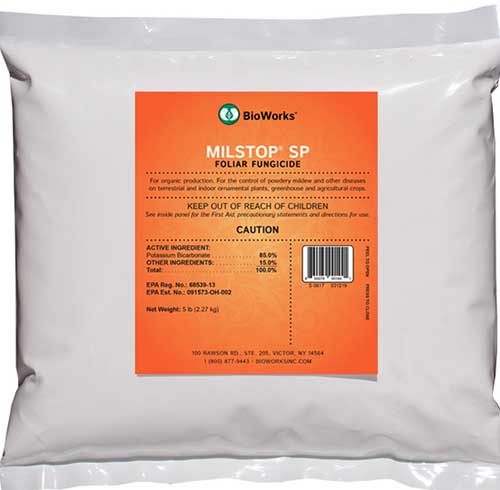

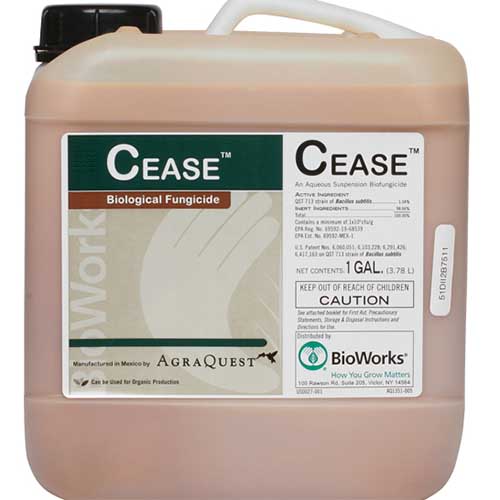
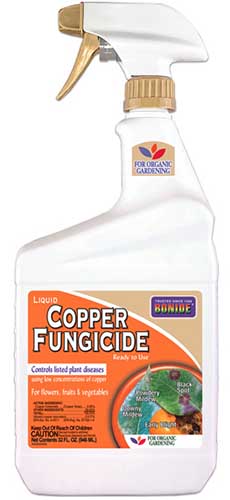
Thanks for all the help. I am anxious to see if the milk solution with water will work for my problem.
Would it be advisable to add a copper or sulfur fungicide to the milk and water solution?
Hi Alex,
You are quite welcome!
I would suggest just trying the milk with water and see if that works. Copper or sulfur are very commonly used, but they can have some side effects on plants that you would not get with when you treat with milk.
Please let us know how the treatment works for you!
Can you use a mixture of apple cider vinegar and water to control Powdery mildew?
Hi Lee,
Thank you for your question!
I have never heard of anyone doing that, which doesn’t mean that it’s not possible. You can try it, but I would advise sticking with remedies that have been shown to work.
You have to be very careful with vinegar to water ratio because it will burn your plants. I learned that from experience. I am going to try the milk method before I use chemicals. Best of Luck!
Hi Helga! Thank you for your informative article on powdery mildew. I have pulled out my pea plants which were infected with this problem and had come to the end of their season here in Southern California. I have also treated sweet peas in the same bed with the milk solution. I would like to know if I should treat the soil area they grew in and the tomato cages I used for supports to prevent future infection. If so, what treatment should I use? I plan on growing corn, peppers and bush beans in this area for summer. Thank… Read more »
Powdery mildew can’t live in the soil, it needs a host to survive. I can’t live on tools like trowels and tomato cages for a short time, so clean those items with a 1:10 bleach to water solution.
Thanks Kristine! I can now get to work in that vegetable bed!
Good morning, On your page how to treat mildew, it says near the top, “Ornamental plants that can face (I presume you mean suffer from) this onslaught include: Asters Bee balm Begonias Dahlias Delphiniums Hibiscus Lilacs Mums Peonies Roses Succulents Verbena Zinnias. Near the end though, it says “Resistant annual and perennial flower cultivars include certain types of Bee Balm, black-eyed Susans, Delphiniums, hardy geraniums, phlox, salvia, Verbena, and Zinnias.” There is some duplication of plants or did I misunderstand? I am struggling with powdery mildew on my Hardy Phlox and am worried it will spread to my other plants.… Read more »
Hi Joan, Thanks for posting your questions. We’re glad you found the article helpful! Maybe we can reword that second line you quoted for greater clarity. I believe the author intended us to understand that certain cultivars of all of those plants were resistant, though I understand that the wording could be slightly confusing! Before you plant your new delphiniums or bee balms in the location where you had powdery mildew, I’d recommend looking up the cultivars to find out if they are resistant to powdery mildew. If they aren’t, locate them somewhere else and choose plants that are described… Read more »
Hi thank you for the information. Do you know if evaporated milk, coconut milk or plant based milk work?
Research is still ongoing in this area, and to the best of my knowledge the exact mechanism or role of certain components of cow’s milk in terms of what makes it an effective remedy for powdery mildew remains unclear. Some sources claim is may be related to the pH of the milk, which is slightly acidic. Others such as this one suggest that a proliferation of Lactobacillus bacteria in milk that’s fermenting in the sun may plays a role. The fat content of the milk may also contribute to its effectiveness, though some sources advocate for using lower-fat milk to… Read more »
Your blogs provide great information, btw…
are you looking for tissue culture plants in USA? if yes Ifield Botanics is the best vendor.
Your blogs provide great information, btw…
Hello, I’m trying Dr Bronners’s peppermint soap diluted with water for a spray. It kills rose chafers, ants and even dog fleas! Anyone else?
You have the best info on powdery mildew. But I used a baking soda veg. oil and dish soap mix last night on my pumpkin plants and now the leaves are black. What do I do?
Why is there so many websites/people saying the baking soda is good to use for white powder fungus? And here you are saying it does nothing??? Just curious, I gotten it the last couple of yrs, but it has been at the end of the season. I get a HUGE yield of pickles , so by the time it over takes them I’m about done for the season. I would like to treat it tho. I’m in the Albany, NY region.
I don’t like the face I was given, LOL I’m not MAD!!! Just curious????? ????♂️????
Haha, sorry! The user icons are randomly assigned, unless you sign up for an account with a dedicated avatar image.
This is correct- studies suggest that baking soda does little against mildew. I’d suggest relying on other more effective techniques and preventive methods with your cucumber plants instead- pruning to improve airflow, avoiding spraying any water on the foliage, etc.
Check out our guide to growing cucumbers for more tips.
I see it every year now here in Windsor, Ontario on ivy, grass, clover. It was on my peas and always on my cannabis, usually only outdoor. I like to use milk and it seems to work.
Thanks for sharing a tried and true method, Cheech.